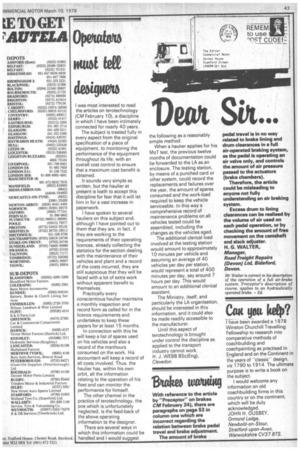*taloa
Page 45

If you've noticed an error in this article please click here to report it so we can fix it.
NWot tete
woo
I was most interested to read the articles on terotechnology (CM February 10), a discipline in which I have been intimately connected for nearly 40 years.
The subject is treated fully in every aspect from the original specification of a piece of equipment, to monitoring the performance of the equipment throughout its life, with an overall cost control to ensure that a maximum cost benefit is obtained.
It sounds very simple as written, but the haulier at present is loath to accept this discipline for fear that it will let him in for a vast increase in paperwork.
I have spoken to several hauliers on this subject and, although I have pointed out to them that they are, in fact, if they are working to the requirements of their operating licences, already collecting the statistics for the section dealing with the maintenance of their vehicles and plant and a record of the costs incurred, they are still suspicious that they will be faced with a lot of extra work without apparent benefit to themselves.
Practically every
conscientious haulier maintains a monthly inspection and record form as called for in the licence requirements and undertakes to keep these papers for at least 15 months. In connection with this he will keep a list of spares used on his vehicles and also a record of the manhours consumed on the work. His accountant will keep a record of all costs involved. Thus, the haulier has, within his own orbit, all the information relating to the operation of his fleet and can monitor the performance for himself.
The other channel in the practice of terotechnology, the one which is unfortunately neglected, is the feed-back of the above operating information to the designer.
There are several ways in which this information could be handled and I would suggest the following as a reasonably simple method: When a haulier applies for his MoT test, the previous twelve months of documentation could be forwarded to the LA as an enclosure. The testing station, by means of a punched card or other system, could record the replacements and failures over the year, the amount of spares consumed and the work-load required to keep the vehicle serviceable. In this way a comprehensive record of maintenance problems on all vehicles tested could be assembled, including the changes as the vehicles aged.
The additional clerical load involved at the testing station would amount to approximately 10 minutes per vehicle and assuming an average Of 40 vehicles per day per station, would represent a total of 400 minutes per day, say around 7 hours per day. This would amount to an additional clerical assistant.
The Ministry, itself, and particularly the LA organisation, should be interested in this information, and it could also be made readily accessible to the manufacturer.
Until this aspect of terotechnology is brought under control the discipline as applied to the transport industry cannot work.
H. J. WEBB BSc(Eng), Clevedon,




















































































































